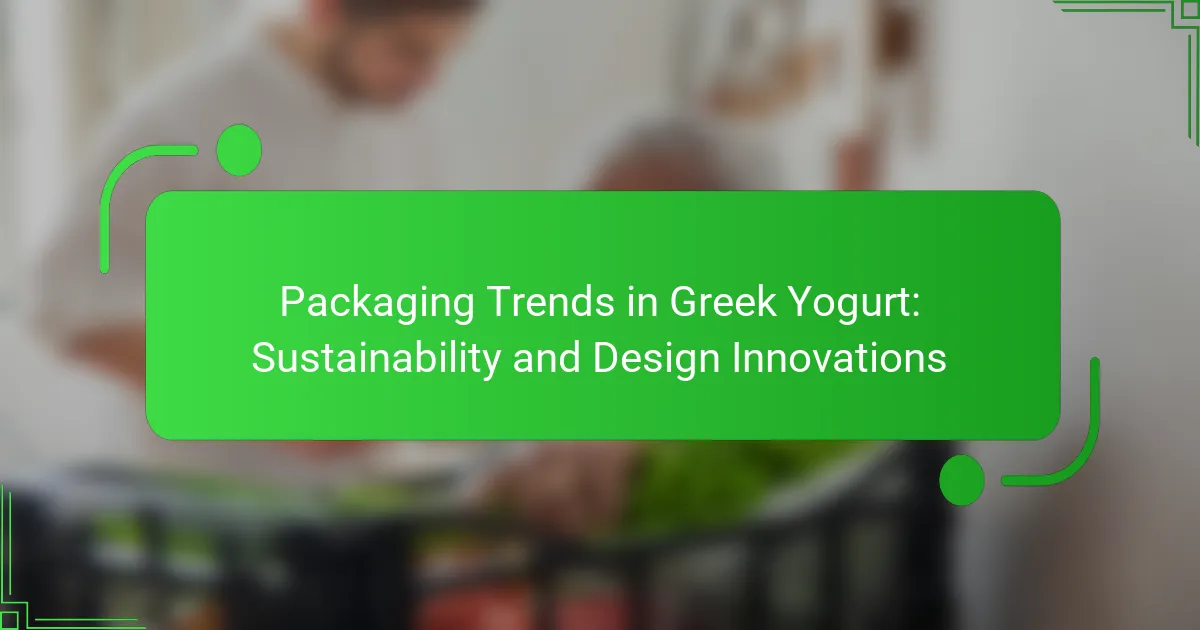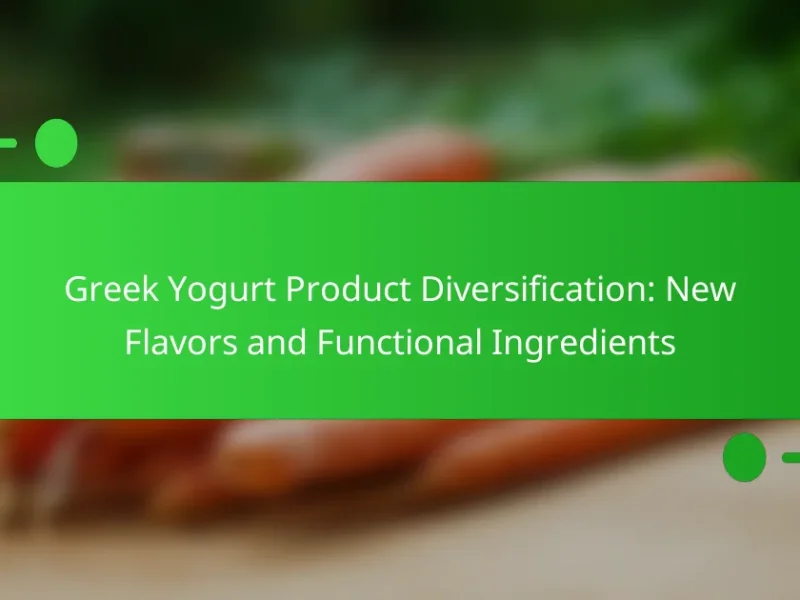The primary entity of this article is Greek yogurt packaging, which is currently influenced by trends emphasizing sustainability and innovative design. Brands are increasingly adopting eco-friendly materials, such as biodegradable plastics and recyclable containers, to minimize environmental impact and align with consumer preferences. Additionally, minimalist packaging designs are gaining traction, catering to health-conscious consumers, while portion control and resealable features enhance convenience. However, brands face challenges in implementing sustainable packaging, including higher costs, limited material availability, varying consumer demand, and regulatory compliance. Overall, the article explores how these trends reflect the growing consumer demand for functionality and environmental responsibility in food packaging.
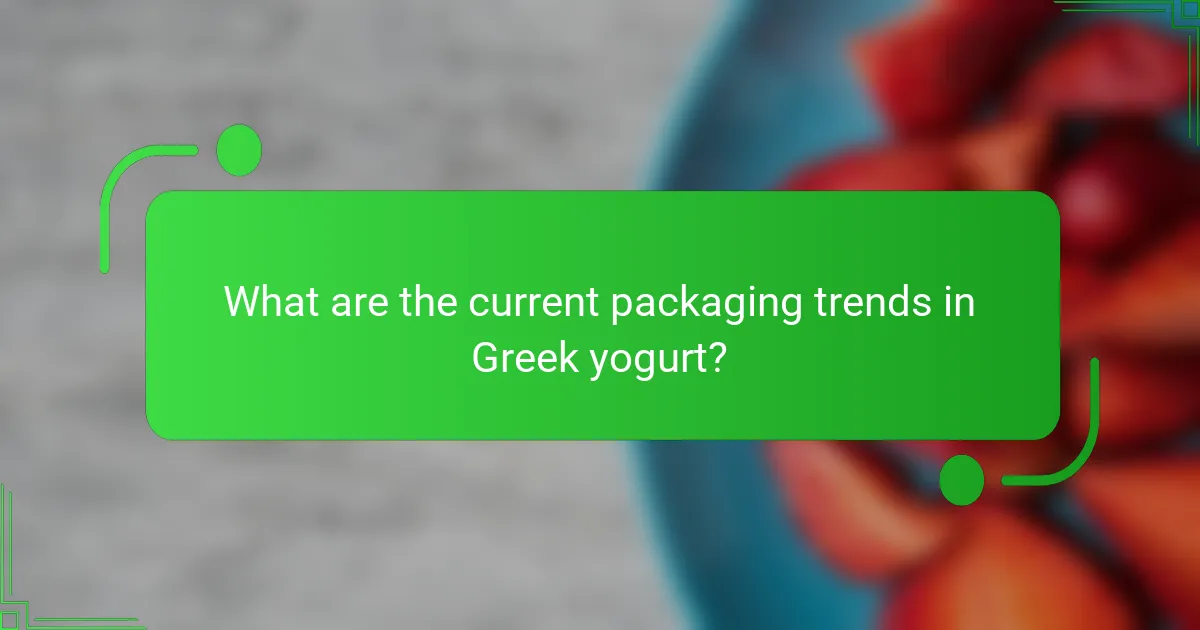
What are the current packaging trends in Greek yogurt?
Current packaging trends in Greek yogurt focus on sustainability and innovative designs. Brands are increasingly using eco-friendly materials, such as biodegradable plastics and recyclable containers. This shift aims to reduce environmental impact. Additionally, minimalist designs are becoming popular. They emphasize clarity and simplicity, appealing to health-conscious consumers. Portion control packaging is also on the rise. It caters to convenience and on-the-go consumption. Notably, brands are incorporating resealable features to enhance usability. These trends reflect consumer demand for both functionality and sustainability in food packaging.
How are sustainability practices influencing Greek yogurt packaging?
Sustainability practices are significantly influencing Greek yogurt packaging. Manufacturers are increasingly adopting eco-friendly materials. This includes biodegradable and recyclable packaging options. Such materials reduce environmental impact and promote sustainability. Additionally, brands are minimizing packaging size to decrease waste. This approach aligns with consumer demand for responsible products. Research indicates that 60% of consumers prefer brands with sustainable packaging. Companies are also investing in innovative designs that enhance recyclability. These trends reflect a broader shift towards sustainability in the food industry.
What materials are being used to enhance sustainability in packaging?
Biodegradable materials, recycled plastics, and plant-based composites are being used to enhance sustainability in packaging. Biodegradable materials break down naturally, reducing landfill waste. Recycled plastics minimize the need for new raw materials. Plant-based composites utilize renewable resources, decreasing carbon footprints. Innovations like mushroom-based packaging are emerging for their eco-friendliness. These materials contribute to a circular economy, promoting reuse and recycling. Studies show that sustainable packaging can significantly reduce environmental impact. For instance, using recycled content can lower greenhouse gas emissions by up to 30%.
How do sustainable packaging options impact consumer choices?
Sustainable packaging options significantly influence consumer choices. Consumers increasingly prefer products with eco-friendly packaging. A study by Nielsen found that 66% of global consumers are willing to pay more for sustainable brands. This trend is particularly strong among younger demographics. Sustainable packaging conveys a brand’s commitment to environmental responsibility. It can enhance brand loyalty and attract new customers. Additionally, consumers often associate sustainable packaging with higher quality. Thus, sustainable packaging options play a crucial role in shaping purchasing decisions.
What design innovations are emerging in Greek yogurt packaging?
Emerging design innovations in Greek yogurt packaging include eco-friendly materials and interactive designs. Brands are increasingly adopting biodegradable and recyclable materials to reduce environmental impact. For instance, companies like Chobani have introduced containers made from recycled plastic. Additionally, some brands are utilizing smart packaging technology. This technology can provide consumers with information about product freshness and nutritional content. Eye-catching graphics and minimalist designs are also trending, enhancing shelf appeal. Innovations like resealable lids improve convenience for consumers. These advancements reflect a growing emphasis on sustainability and user experience in the Greek yogurt market.
How are brands incorporating aesthetics into packaging design?
Brands are incorporating aesthetics into packaging design by using visually appealing graphics and colors. They focus on creating unique shapes and textures to differentiate their products. Many brands emphasize minimalist designs to convey premium quality. Sustainable materials are also being used to enhance the visual appeal while promoting eco-friendliness. Typography plays a crucial role in communicating brand identity and product information effectively. Research shows that attractive packaging can significantly influence consumer purchasing decisions. For example, a study published in the Journal of Consumer Research found that visual aesthetics can enhance perceived value and desirability.
What role does functionality play in the design of yogurt containers?
Functionality is crucial in the design of yogurt containers. It ensures that the container effectively protects the yogurt while maintaining freshness. Functional designs include features like resealability and portion control. These features enhance user convenience and minimize waste. Additionally, ergonomic shapes improve handling and storage. Research indicates that consumers prefer containers that are easy to open and pour. Effective functionality can also influence purchasing decisions. Overall, functionality directly impacts consumer satisfaction and product usability.
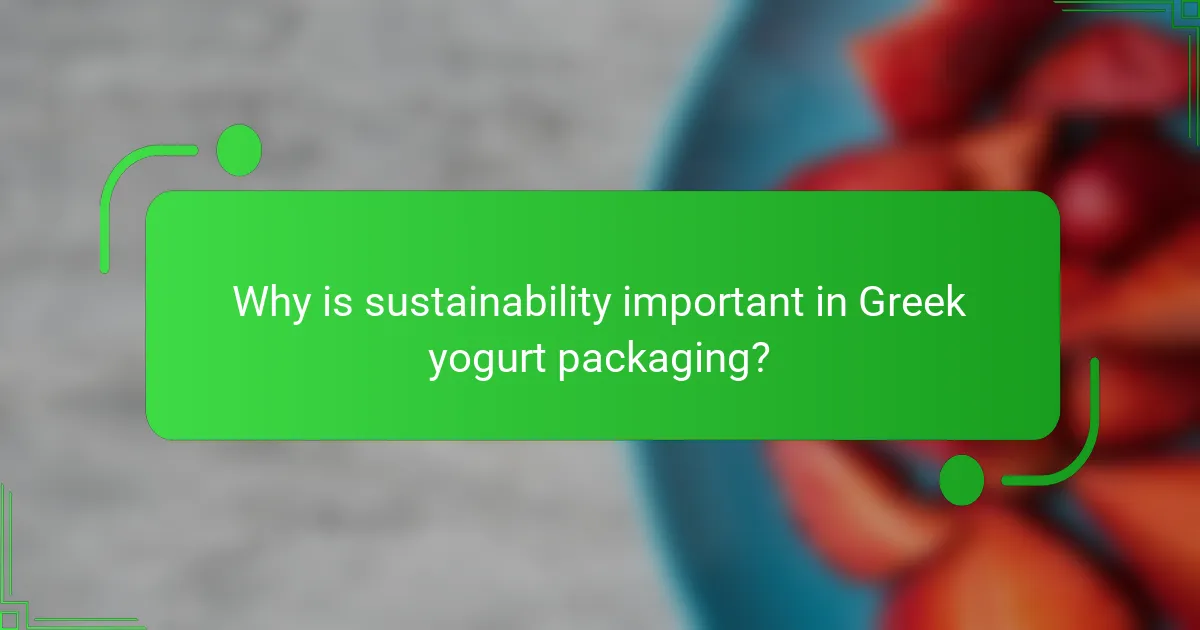
Why is sustainability important in Greek yogurt packaging?
Sustainability is crucial in Greek yogurt packaging to minimize environmental impact. Eco-friendly packaging reduces waste and pollution. Many consumers prefer brands that prioritize sustainability. This choice influences purchasing decisions significantly. Sustainable materials can also enhance brand image. Research indicates that 66% of consumers are willing to pay more for sustainable products. Additionally, sustainable packaging often meets regulatory standards. This compliance can prevent legal issues and enhance market access. Overall, sustainability in packaging aligns with consumer values and environmental responsibility.
What environmental benefits are associated with sustainable packaging?
Sustainable packaging reduces environmental impact significantly. It minimizes waste by using biodegradable or recyclable materials. This type of packaging often requires less energy to produce. According to the Environmental Protection Agency, recycling can save up to 95% of the energy needed to create new products from raw materials. Sustainable packaging also decreases carbon emissions during production and transportation. A study by the World Economic Forum found that sustainable packaging can reduce greenhouse gas emissions by 30%. Additionally, it encourages responsible consumer behavior and promotes a circular economy. These factors collectively contribute to a healthier planet.
How does sustainable packaging reduce waste in the yogurt industry?
Sustainable packaging reduces waste in the yogurt industry by utilizing biodegradable or recyclable materials. These materials minimize environmental impact compared to traditional plastic packaging. For instance, biodegradable packaging decomposes naturally, reducing landfill contributions. Additionally, recyclable packaging encourages consumers to recycle, further decreasing overall waste. Studies indicate that sustainable packaging can reduce plastic waste by up to 50%. Implementing these practices helps yogurt brands meet consumer demand for eco-friendly products. Brands adopting sustainable packaging can enhance their market appeal and contribute to a circular economy.
What are the long-term effects of sustainable practices on the environment?
Sustainable practices have significant long-term effects on the environment. They reduce carbon emissions, which helps mitigate climate change. For instance, adopting renewable energy sources can lower greenhouse gas outputs by up to 80%. Sustainable agriculture enhances soil health and biodiversity. This leads to improved crop yields over time. Additionally, waste reduction initiatives can decrease landfill use, promoting a circular economy. Research indicates that sustainable packaging can reduce plastic waste by 30% in the food industry. Overall, these practices contribute to a healthier ecosystem and promote resource conservation.
How do consumers perceive packaging innovations in Greek yogurt?
Consumers generally perceive packaging innovations in Greek yogurt positively. They appreciate sustainable packaging options that reduce environmental impact. Innovations such as recyclable materials and reduced plastic usage resonate well with eco-conscious buyers. Eye-catching designs also attract attention on store shelves. Research indicates that 74% of consumers are willing to pay more for sustainable packaging. Convenience features, like resealable lids, enhance user experience and satisfaction. Overall, packaging innovations significantly influence purchasing decisions in the Greek yogurt market.
What factors influence consumer preferences for packaging designs?
Consumer preferences for packaging designs are influenced by several key factors. These factors include sustainability, aesthetics, functionality, and branding. Sustainability is increasingly important as consumers prefer eco-friendly materials and designs. Aesthetics play a crucial role, as visually appealing packaging attracts attention and enhances perceived value. Functionality, such as ease of use and resealability, affects consumer satisfaction. Branding consistency helps consumers connect with products, reinforcing loyalty. Research indicates that 70% of consumers are willing to pay more for sustainable packaging, highlighting its significance. Thus, these factors collectively shape consumer choices in packaging design.
How can brands effectively communicate their packaging innovations?
Brands can effectively communicate their packaging innovations through clear messaging and targeted marketing strategies. They should highlight the unique features of their packaging, such as sustainability and design improvements. Utilizing visual content, like videos and infographics, can enhance understanding. Engaging storytelling can create an emotional connection with consumers. Social media platforms serve as effective channels for sharing these innovations widely. Collaborations with influencers can amplify the message. Providing transparency about materials and processes builds trust with consumers. Research indicates that 70% of consumers prefer brands that demonstrate sustainability efforts, emphasizing the importance of effective communication in packaging innovations.
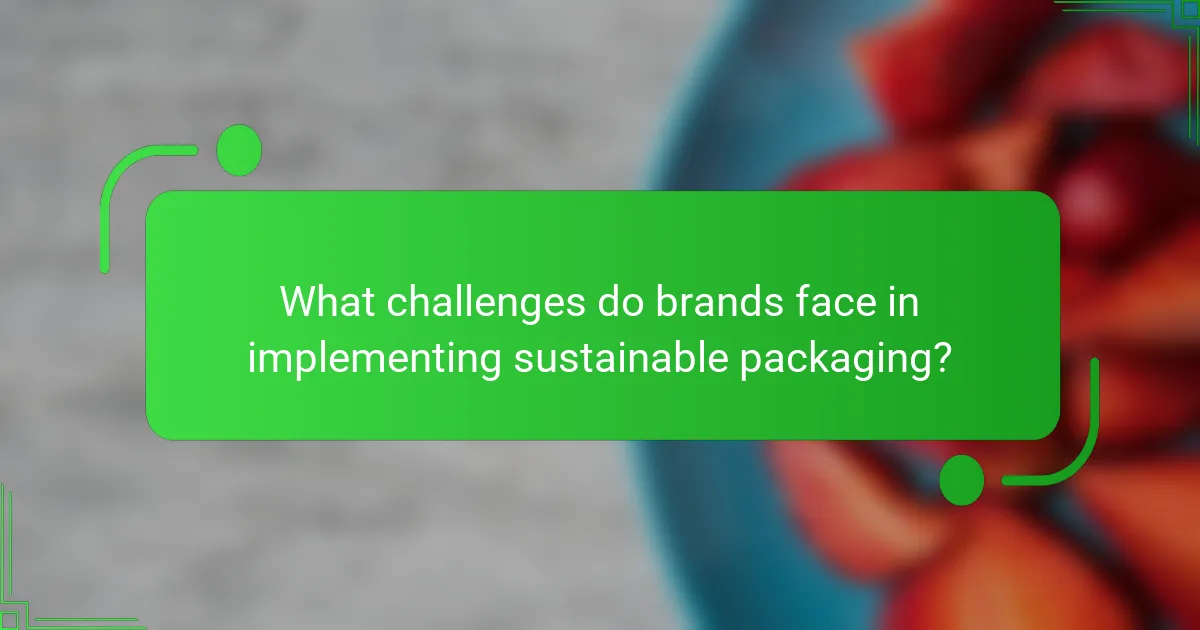
What challenges do brands face in implementing sustainable packaging?
Brands face significant challenges in implementing sustainable packaging. These challenges include higher costs associated with sustainable materials. Many sustainable options are more expensive than traditional packaging. There is also limited availability of sustainable materials in certain regions. Brands often struggle to find suppliers that meet sustainability criteria. Additionally, consumer awareness and demand for sustainable packaging can vary. Some consumers may not prioritize sustainability when making purchasing decisions. Regulatory compliance presents another challenge, as laws regarding packaging can differ by location. Brands must navigate complex regulations to ensure compliance. Finally, the need for innovation in design can be a hurdle. Developing packaging that is both sustainable and functional requires creative solutions.
What are the cost implications of sustainable packaging materials?
Sustainable packaging materials often incur higher initial costs compared to traditional options. This is due to the sourcing of eco-friendly materials and the manufacturing processes involved. For example, bioplastics and recycled materials can be more expensive to produce. However, these costs can be offset by potential savings in waste management and consumer appeal. Research indicates that companies adopting sustainable practices may see increased customer loyalty and sales. A study by the Ellen MacArthur Foundation found that sustainable packaging can enhance brand reputation and drive long-term profitability. Therefore, while the upfront investment may be significant, the overall financial implications can be favorable in the long run.
How do supply chain issues affect the adoption of sustainable practices?
Supply chain issues hinder the adoption of sustainable practices by disrupting the availability of eco-friendly materials. When supply chains face delays or shortages, companies may resort to less sustainable options. This reliance on traditional materials often compromises sustainability goals. Additionally, increased costs associated with sustainable materials can lead to budget constraints. Companies may prioritize short-term financial stability over long-term sustainability initiatives. According to a 2021 report by McKinsey, 70% of companies cited supply chain disruptions as a barrier to implementing sustainable practices. Therefore, the stability of supply chains is crucial for advancing sustainability in packaging trends, particularly in sectors like Greek yogurt.
What technological barriers exist in the development of innovative packaging?
Technological barriers in the development of innovative packaging include material limitations, production complexities, and regulatory constraints. Material limitations arise from the need for sustainable and biodegradable options that also maintain product integrity. Production complexities can hinder the integration of advanced features such as smart technology or enhanced barrier properties. Regulatory constraints may restrict the use of certain materials or technologies in food packaging. These barriers can slow down the adoption of innovative solutions in the packaging industry.
How can brands overcome challenges in sustainable packaging?
Brands can overcome challenges in sustainable packaging by adopting innovative materials and designs. Utilizing biodegradable or recyclable materials reduces environmental impact. Implementing efficient supply chain practices minimizes waste during production. Collaborating with sustainability-focused suppliers enhances access to eco-friendly options. Educating consumers on proper disposal methods increases recycling rates. Investing in research and development fosters new sustainable packaging solutions. According to a study by Smithers Pira, the global sustainable packaging market is projected to reach $500 billion by 2027, indicating strong industry momentum.
What strategies can be employed to reduce costs in sustainable packaging?
Employing strategies such as material optimization, bulk purchasing, and innovative design can effectively reduce costs in sustainable packaging. Material optimization involves selecting cost-effective, eco-friendly materials that meet sustainability goals. For instance, using recycled materials can lower production costs while reducing environmental impact. Bulk purchasing of materials can lead to significant cost savings due to economies of scale. Innovative design can minimize material usage without compromising functionality, which can also reduce costs. Implementing efficient production processes can further decrease waste and lower overall expenses. These strategies collectively enhance sustainability while ensuring cost-effectiveness in packaging solutions.
How can collaboration within the industry foster innovation?
Collaboration within the industry can foster innovation by pooling resources and expertise. When companies collaborate, they share knowledge and insights, leading to new ideas. For instance, joint research initiatives can explore sustainable packaging solutions. This collaboration can result in innovative materials that reduce environmental impact. Additionally, partnerships can streamline production processes, improving efficiency. Industry collaboration can also drive consumer engagement through co-branded products. According to a study by the Harvard Business Review, companies that collaborate effectively can increase their innovation output by up to 20%. This evidence supports the notion that collaboration is vital for fostering innovation in packaging trends for Greek yogurt.
What best practices should brands follow for packaging Greek yogurt?
Brands should prioritize using sustainable materials for packaging Greek yogurt. Eco-friendly options include biodegradable plastics and recyclable materials. These choices reduce environmental impact and appeal to eco-conscious consumers. Brands should also ensure that packaging is airtight to preserve freshness and extend shelf life. This helps maintain product quality and reduces food waste. Clear labeling is essential for informing consumers about ingredients and nutritional content. Transparency builds trust and encourages informed purchasing decisions. Additionally, brands should consider portion control packaging to cater to health-conscious consumers. This approach can enhance convenience and reduce overconsumption. Finally, innovative designs can attract attention on store shelves. Unique shapes and vibrant graphics can differentiate products in a competitive market.
How can brands balance sustainability and design in their packaging?
Brands can balance sustainability and design in their packaging by using eco-friendly materials and innovative designs. Sustainable materials include recycled paper, biodegradable plastics, and plant-based inks. These materials reduce environmental impact while maintaining aesthetic appeal. Innovative designs can enhance functionality, such as using minimal packaging to reduce waste.
Research shows that 66% of consumers are willing to pay more for sustainable brands. This indicates a market demand for eco-conscious packaging. Additionally, brands can incorporate clear labeling to communicate sustainability efforts. This transparency builds consumer trust and loyalty. By aligning design with sustainable practices, brands can achieve both visual appeal and environmental responsibility.
What are the key considerations for effective consumer communication regarding packaging?
Key considerations for effective consumer communication regarding packaging include clarity, transparency, and engagement. Clarity ensures that product information is easily understood. This includes using straightforward language and clear visuals. Transparency involves providing honest information about ingredients, sourcing, and sustainability practices. Engaging packaging can attract consumer attention and encourage interaction. Research indicates that consumers prefer brands that communicate their values effectively. A study published in the Journal of Consumer Research found that transparent packaging can enhance brand trust and loyalty.
The main entity of this article is Greek yogurt packaging, with a focus on sustainability and design innovations. The article outlines current trends in packaging, emphasizing the use of eco-friendly materials, minimalist designs, and functionality, such as portion control and resealable features, to meet consumer demand for convenience and environmental responsibility. It discusses the impact of sustainability practices on packaging choices, consumer preferences, and the challenges brands face in implementing these innovations. Additionally, it highlights the importance of effective communication and collaboration within the industry to foster innovation and address cost implications associated with sustainable packaging.
